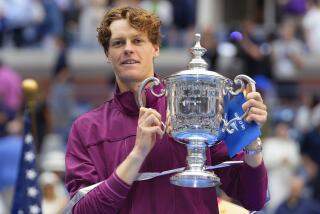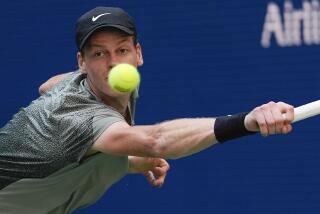Keep Your Eye on His Racket
- Share via
NEW YORK — If you just dropped in from Mars and watched Marat Safin talk about his match Monday at the U.S. Open tennis tournament, you’d think he was some poor sap who had gone out and gotten crushed.
Safin is the gloomy Russian. Morose Marat. His glass always seems half empty. If he won the lottery, he’d bemoan the taxes. He’s probably not sure Santa Claus is a good thing.
Monday, he played somebody he had lost to four times in nine tries, including their last two matches, and finished his third-rounder with Olivier Rochus of Belgium in an hour and a half and just 26 games, 6-3, 6-2, 6-3. Afterward, instead of celebrating that, he sounded like a man whose dog had just died.
Asked about his fourth-round match today against Tommy Haas, he said, “I think it will be really tight....I’m a little bit lucky maybe.”
Safin might be the tour leader in low self-esteem and high explosions -- former ATP tour star Goran Ivanisevic once nominated Safin as the person most likely to succeed him as the best racket-thrower on the tour.
“He has that commitment when he throws,” Ivanisevic said. “When he throws, it will break. No halfhearted throw. He has perfect follow-through.”
As Safin hunched over the microphone in his news conference and mumbled answers in his deep voice, the unshaved face and disheveled hair somehow enhancing rugged good looks, it was necessary to recall that this is one of the best players ever.
He is only 26, has won two Grand Slam tournaments, been No. 1 in the world for a run of nine weeks in late 2000 and early 2001, and has won nearly $13 million in his career.
And there he was Monday, having made his way into the fourth round, with a reasonable shot at getting to Roger Federer in the semifinals, and with the knowledge that he knows how to do this, because he has done it before. In 2000, he became the U.S. Open men’s singles champion by beating no less than Pete Sampras in the final. And by doing so in straight sets. It was 6-4, 6-3, 6-3, and even Sampras has since admitted that he had seldom seen anybody play quite that well for an entire match.
To show that that 2000 U.S. Open was no fluke, Safin won another major last year, beating Australian favorite Lleyton Hewitt on friendly turf in the Australian Open final after having achieved what few others have since: beating Federer in the semifinals.
So what’s the problem?
Mostly, Safin’s career has been a roller coaster of injuries. He started 2001 at No. 1 and finished at No. 11. He finished 2003 at No. 77, then got back to No. 4 by the end of 2004. In 2005, he started with the Grand Slam win in Australia but had slipped to No. 13 by the end of the year. He has had knee injuries, elbow injuries, rib injuries and wrist injuries. His body is more like an NFL linebacker’s than a tennis player’s. Some years, he has been forced to disappear to the rehab center for half the season.
Incredibly, he entered Monday’s match against Rochus ranked No. 104. Rochus was No. 30 and seeded No. 26. On the form sheet, it looked like a rout, but veteran Rochus knew better.
“He is a top-five player right now,” he said. “With his forehand going like it was and his serve, I had no chance.”
Safin hit 40 winners to 12 for Rochus, and of those 40 winners, 12 were aces.
Rochus said that his only hope against a sound Safin is if the Russian’s famous volcanic temper kicks in. Rochus said that was what happened when he beat Safin this year in the round of 16 in Dubai.
“He was hitting lots of shots off the fence,” Rochus said.
The three victories Safin has put together here are his first at the U.S. Open since 2002. He had a bad knee last year and didn’t play. He lost in the first round in 2004 and missed the event in 2003 with a bad wrist. In 2002, he went one round before being bounced by Gustavo Kuerten in straight sets.
Despite that, he indicated a certain healing taking place here.
“I’m moving better, faster,” he said. “Better anticipation. Basically, enjoying it a little more. I’m having fun on the court, so I guess it’s New York.”
That was pretty upbeat. He almost smiled when he said it.
More to Read
Go beyond the scoreboard
Get the latest on L.A.'s teams in the daily Sports Report newsletter.
You may occasionally receive promotional content from the Los Angeles Times.











